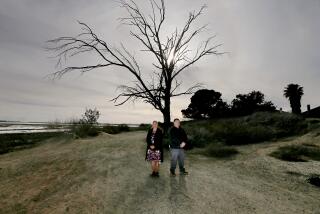Chumash Village Found in Agoura Hills
- Share via
Archeologists say they have discovered what is believed to be the remains of a Chumash Indian village on an Agoura Hills slope earmarked for a 178-unit apartment project.
After a week of unearthing artifacts--from beads to animal bone chips to arrow points--archeologists have determined the village dates to between AD 1200 and AD 1600 and was home to about 25 Chumash Indians living in three or four dwellings.
The village is similar to at least five other known Chumash Indian hamlets buried in the foothills south of Agoura Road, archeologist Mark Raab, director of California State University, Northridge’s Center for Public Archeology, said Friday.
More Findings Foreseen
“This site is unusual in that the hillside has created a pocket of land that has been preserved,” Raab said. “The several test pits we have dug indicate that the site is filled with thousands of artifacts.”
Also, Raab said, a small burial ground is likely nearby.
The discovery of the village, on nine of the parcel’s 23 acres, will not affect construction, however. The developer had planned all along to keep the involved area, on the top of the slope, free from building.
The Chumash, one of the largest and most important tribes in California, ranged from from San Luis Obispo to Malibu Canyon on the coast and inland as far as the western edge of the San Joaquin Valley.
The Agoura Hills planning director notified CSUN archeologists of the site at the urging of Patricia Uebersax, a local resident who recently received a bachelor’s degree in archeology and realized there might be a Chumash village on the property, Raab said.
1977 Reports Confirmed
He said his research turned up two 1977 reports showing that visual surveys of the property indicated the land was of historic significance. The CSUN Center for Public Archeology, along with a similar center at UCLA, serve as clearing houses for locating archeological sites in Los Angeles County.
The developer, Tarzana-based Lincoln Property Co., was unaware that the plot contained a significant archeological site.
“It came as a complete surprise to us. To tell you the truth, I never even thought of the issue,” said Michael Sondermann, a partner in the development firm. The property had been through an environmental impact report and had been approved by the county and city, and the issue never came up.”
Sondermann said he contracted with Raab to conduct a $400 initial survey of the property last week. After a quick walk up the hillside, Raab said he could see that the land is a “gold mine” of information. The full survey cost Sondermann $12,000.
“I knew immediately it was significant, because the earth here is dark brown and the rest of the area is a light brown,” Raab said, a sign that the soil has been enriched by human occupation.
A 1970 state law requires that developers have archeologists supervise digging on any construction site that might yield artifacts of historical significance.
Developer Donating Findings
Although the artifacts become the developer’s property, Sondermann said he is donating them to the Northridge center.
Raab said three survey pits were dug on the property. The team will complete its work at the site on Wednesday. The property will be fenced off during construction, which is scheduled to begin on the lower part of the hillside on May 1.
Posh Moyle, a Chumash Indian with the United Southern Chumash Council, monitored the dig and said she was pleased that the artifacts were being treated with the “ultimate amount of respect.”
“For us,” Moyle said, “it is in a way very sad to see that what was put into the ground is being taken out. There is some hurt. But overall, there will be a good feeling because the site will be protected.”
More to Read
Sign up for Essential California
The most important California stories and recommendations in your inbox every morning.
You may occasionally receive promotional content from the Los Angeles Times.













